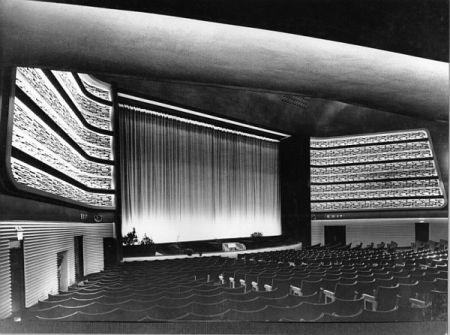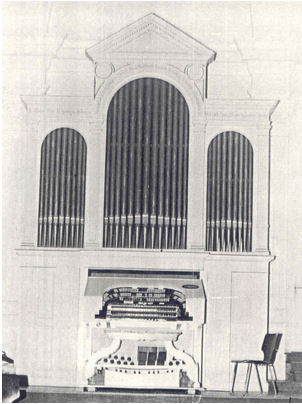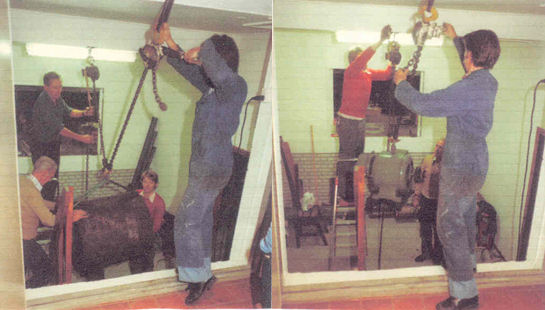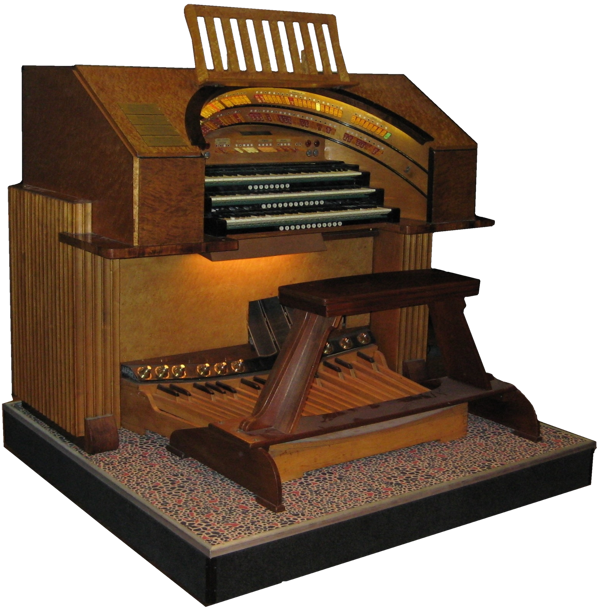The Compton Theatre Organ has a rich history, which such a magnificent organ deserves. From December 2, 1983 to December 3, 2003, the Compton 3/11 theatre organ played in the Concert and Auditorium in Middelburg. It might be interesting to take a moment to reflect on a bit of the history of this instrument.
| Some quick numbers: 1935 – 1961 The Majestic Cinema in Rochester; 1961 – 1981 Roman Catholic Church in Orpington-Kent 1981 – 2005 Concert- and Auditorium in Middelburg 2005 - far into the future ;-) Draaiorgelmuseum in Haarlem. We then go back to 1935 when the organ was built. |
 |
The John Compton Organ Company
The demand for theatre organs at the beginning of the last century resulted in the manufacture of these organs in various parts of the world.
The pipework, regardless of the make, was all of equal construction and character.
Based on the romantic style of the classical organs around 1900.
The electrically driven wind supply was technically at a far advanced stage at the time, that this type of “unit” organ – also called “extention” organ – was accepted as the most suitable organ for theatres.
The electromagnets, necessary to control the wind supply for the pipes in the wind chests, had been given the predicate “reliable”.
Apart from such electro-pneumatic actions for the pipes and percussions, such mechanisms were also used for the so-called multi-contact relay. The relay, with the function of the central switching system between the console and the pipework, can be compared to the function of the telephone exchange as a central link between subscribers in a telephone conversation. Organ builders based the relays on the system developed by Würlitzer, after the ideas of the Englishman Robert Hope Jones. However, this system required a lot of space and wind supply and was therefore very expensive. John Compton was the only organ builder to start experiments with a system that used direct electro-magnets and made the expensive wind supply with its pneumatic actions redundant.

from left to right: Pedal, Accompaniment, Great, Solo.
The Compton “direct-electric” relay was so compact that it could be placed in a narrow cabinet against a wall.
This system had the added advantage that the control and adjustment of contacts could be done while the organ was fully functioning.
With organs from other manufacturers, the wind supply had to be shut off first.
The manufacturers also applied the pneumatic system in the console for the operation of the registers, register rockers, etc.
John Compton was the first to introduce the “all-electric” console, by again using electro-magnets for these functions.
Even today his example is followed - even in church organs. Experience has shown that these applications in relays and consoles - if correctly adjusted - leave little to be desired and respond to the pipes as quickly as the electro-pneumatic systems.
John Compton was surrounded by a very inventive team. The esteemed organist James I. Taylor was his co-director. There was no question of imitating the work of Hope Jones.
In 1918 John Compton installed his first master organ. The 4-manual organ with 17 ranks of pipes (4/17) installed in 1923 in the Pavillon Theatre in Shepers Bush London, was generally regarded as a great triumph for John Compton. After all, this organ had all the "direct-electric" applications in the console and in the relay.
In 1939 Compton had already built more than 500 church and theatre organs. Unfortunately, it must be admitted that Compton built many small organs with a less beautiful sound quality. However, the customer wanted a maximum sound to be produced by as few pipes as possible. But herein lay the great strength of Compton, namely the very far-reaching implementation of the “Unit” or “Extention” principle.
As a result, a Compton organ – compared to, for example, a Würlitzer organ of the same size – is significantly larger in the number of registrations and “Orchestral” sound.
The large production and the cost aspect made Compton decide to also have the Tibia pipes made of metal and to only supply wooden pipework to order at an additional cost. A well-adjusted tremulant connected to a metal Tibia very closely approximates the sound quality of the traditional wooden Tibia.
Although the Compton pipework was made by a few specialists (the Reeds pipes for example by Norman, Beard and Hill, the Flutes by Rushworth and Draper or Booth), the rest of the theatre organ was entirely self-made. Even the plastic register rockers were cast by Compton himself.
Larger pipes were placed on a patented seat, which realized a variable wind supply. Comparable to the iris of a camera. Such trifles were typical of Compton's ingenious craftsmanship. Whether or not other organ builders admitted it, Compton was the leader in the organ profession.
In the late sixties the firm had financial problems, which resulted in Compton being taken over in parts by other firms.
Compton should only be judged by its technical superiority in the past. This is best illustrated by the comment of a leading organ builder from America who (knowing only the traditional relay systems of his own country) studied the setter mechanism and relay of a large Compton organ. He slowly shook his head and said: "It is unbelievable!"
The largest and in all respects the best "dual-purpose" organ in Great Britain is the organ in the Guildhall, Southampton. This organ with its more than 4000 pipes in 50 voices, was built in 1937. The organ has two consoles. One console for the theatre organ section and a 4 manual “classical” console, entirely in the church organ tradition. The organ is still played regularly. This was also a Compton organ.
The Compton of Middelburg
It was a unique fact that the Concert and Auditorium in Middelburg was the first concert hall outside England to have a “Unit” concert organ. And even more unique was the fact that it was also the largest Compton organ outside the borders of Great Britain.
Under construction number A 276, at the then very high cost price of £6000, the organ left the then John Compton Organ Works in London in 1935.
The destination was the Majestic Theatre in Rochester – Kent.
This theatre was privately built by the brothers David and Harry Weston, who also owned the Palace Theatre in Chatham and the Ebassy Theatre in Chadwell Heath.
The Majestic had a very modern decor for that time and almost 2200 spectators found ample space in it. It was the great pride of the Weston brothers and only the best was good enough for this film palace. That also applied to the organ. This Compton became a “One-off” model, designed by James Taylor. It therefore also cost considerably more than the average organs.
The theatre was on the corner of “High Street” and “Star Hill” in Rochester. The opening was on April 15, 1935.
There were 1398 places “stalls” and 783 places made in a circle.


The console was equipped with glass sides, in which lamps of different colours could lighten up. These lamps were operated by the organist on the console.


The organ thus formed a whole with the theatre's decor.
The Odeon/Geaumont/Majestic theatre was closed on 31 October 1981 and was demolished in early 1987.
In 1935 the organ was opened by Cecil Atkinson.
After 6 months he was succeeded by Jack Hartland.
After another year he was succeeded by Clarence Barber.
Early in 1937 the brilliant Lew Harris became the permanent player as “Resident Organist” on what he described as his favorite organ.
 |
| Jack Hartland |
|
George Blackmore, a student at King School College in Rochester, became very friendly with Lew Harris and received from him – in addition to his classical organ training – a very intensive training on the Compton theatre organ. It is therefore not surprising that George had to replace Lew for 10 days during his illness, completely unexpectedly.
George Blackmore |
|
Until 1950 the organ was played during guest performances by Bobby Pagan, Louis Mordish and Terence Casey, among others.
|
| Allan Lusty |
Now there is a senior citizens' flat with 55 apartments.
In August 1981, the Zeeuwse Theater Orgel Stichting (founded on 7 August 1979) dismantled the organ in the church. Just before the wrecking ball would hit the proud convent of the church-monastery-school in Orpington.
The dismantling of the organ in the church of Orpington is a special story. With the help of English Organ Friends, 6 boys (school leavers) and looking for some pocket money and the late Stephan Lokkerbol - who took care of loading the 12-metre-long container - the organ was dismantled in just 3 days.
The console, the blower with motor and dynamo and the relay were transported from the choir balcony of the church to the ground floor with the help of a hoist. All wind chests and pipes had to be brought down via a narrow spiral staircase.
At the beginning of 1983, the Z.T.O.S. by purchasing the original Compton Muted Trumpet, Clarinet, Tibia 16’ and also Compton Xylophone, Glockenspiel and Orchestra Bells to restore the organ to its original condition.
Restoration and Reinstallation
Arriving in Middelburg, the container was quickly unloaded on a Saturday morning.
The organ was stored in parts in the building "De Waag" in Middelburg.
 |
In September 1981, the restoration of the organ was started. A dedicated team of organ enthusiasts repaired, renewed or restored the console, relays, blower, motor, dynamo, wind chests, shutters, regulators and tremulants. The blower with motor and dynamo were checked at De Schelde in Vlissingen. The motor was made suitable for 380 volts. In England, it ran on 440 volts. |
The parts that have been purchased in the meantime, such as effects, drums, xylophone, chimes and orchestra bells, have been thoroughly overhauled and, where necessary, fitted with new bellows or diaphragms.
Arthur Noterman, former partner of Noterman Organbuilders of London, made the 12 wooden Tibia 16’ pipes with completely new wind chests.
The purchased “Steck” piano comes from the now demolished Plaza Theatre in Birkenhead. The piano restoration workshop “De Hamernoot” in Middelburg provided the piano – completely free of charge – with new felt, hammers and strings. The bellows block of the piano was restored by the team and partly fitted with new bellows.
In July 1983, the Middelburg Municipal Works Department was responsible for the renovation under the stage of the Concert and Auditorium for the necessary organ chambers and wind chamber. All this was designed by ir. Eric Halsall, head of the technical team of the Lancastrian Theatre Organ Trust. His experiences, incorporated in the layout of our organ, were indispensable and very valuable during the reinstallation.
At the beginning of September 1983, the installation of the organ in the Concert and Auditorium began. A handful of organ enthusiasts devoted all their free time to building the organ for 3 months.
|
|
|
The installation of the blower with motor and dynamo was quite a heavy job. This whole thing weighs about 800 kg. |
The installation of the wind chests was a technical task and very time-consuming. As was the rewiring of the wind chests. After that, the organ was balanced and tuned by Dick Le Grice, a skilled English craftsman in this field.
And so, on 2 December 1983, the organ was inaugurated during the opening concert as the “Lady Compton of Middelburg”. The nickname “Lady” was given to the organ by Lady Grace Rycroft of York, who had admired the organ since 1939.
Up to the opening concert, approximately 3300 man-hours had been spent on the organ.
| The opening concert was given by the aforementioned George Blackmore, Joyce Alldred and the then 19-year-old Carolyn Riddick. The late Jan van Weelden, who was also supposed to play that evening, had to cancel due to an operation. On December 3, 2003, the closing concert was given by organist Bernd Würtzenrainer. The audience decreased and the Z.T.O.S. decided to stop giving concerts. In 2005, the hall was closed by the municipality of Middelburg. No more performances were allowed because the hall did not meet the fire regulations. The municipality ordered the Z.T.O.S. to remove the Compton organ from the hall.. |
 |
The Concert and Auditorium in Middelburg

As early as 1815, the municipal militia of Middelburg had a music corps and in 1816 there was a singing association. The Middelburg branch of the Society for the Promotion of the Arts, founded in 1829, was given its own concert hall at the Groenmarkt in 1839. The users of this concert hall, including the singing association Tot Oefening en Uitspanning (founded in 1834), received the message in 1895 that they could no longer use their concert hall due to the restoration of the Abbey buildings – which also included the concert hall at the Groenmarkt.
The interested parties then set up a committee whose aim was to obtain, and if necessary build, another building. The committee set to work with great vigour and soon a large house at the Singelstraat, called “Doet wel en siet niet om” was found.
After this building had been renovated, the Concert and Auditorium was officially opened on Wednesday 21 October 1896.
During the Second World War, German troops were stationed in the hall and after the liberation of Middelburg in 1944, the Allies. After that, the hall was used as a warehouse for a while. In 1946, the hall was restored to its former glory.
In terms of acoustics, this hall was in 6th place on the European ranking.
After the renovation of the hall in 2006, it will be used as the home base and rehearsal space of the Zeeuws Orkest.
On the stage in the Concert and Auditorium is an organ front. This is the remaining part of the Wilhelm Sauer organ, which played in the hall until the Second World War. During the war, the interior was largely demolished. The pipework was moved to the attic of the hall and the wind chests were burned on the street during a cold famine winter to provide some warmth.
 |
While the organ was being built into the organ chambers under the stage, we used the space behind the organ front to place the relay and the toy counter. The console found its place behind the doors in the front, where the console of the Sauer organ once stood. Of course, that was a handicap for the organist. On top of the stage, he sat quite far from the audience. |
|
which allowed the audience to watch the organist.
|
 |
| Jan van Weelden during a concert. |
This changed later. Through contacts we came into the fortunate possession of quite a lot of PTT cable when moving an office. The multi-core cables, which would otherwise have ended up in the container, were now used to make a new connection between the console and the relay. This connection was laid under the stage to create the possibility of placing the console in the hall as well.
At the same time we found a new home for the console in the storage room of the hall manager. We were able to bring the console onto the stage using the lift.
That also provided more possibilities. The connection to the console was so long that it could be placed in the middle of the hall. On one occasion with a choir the console was placed in the hall against the stage.
The piano was stored in the place where the console used to be. So in the old Sauer organ front behind the doors. Until then we had to take it to the wind room after every concert. A “weighty” job. Because the rail where the piano could be placed on the stand could be removed in the wind room, we also had more space there to show people around. Many people bumped their heads against it. You had to duck under it to get to the Solo room.
The Zeeland Theatre Organ Foundation
In short ZTOS was founded on August 7, 1979.
A few years were spent mainly by the late Willem Brouwer, the late Stephan Lokkerbol and myself to install a theater organ in Zeeland. Willem in particular played an important role in this. Partly due to the many contacts he had in this world, especially in England.
And then at a certain point you have an organ. Then a lot has to be arranged, including money, subsidies and of course the purchase. Hence the establishment of this foundation, so that everything was arranged legally. As a foundation you are a legal entity.
From the moment that the Compton was unloaded in the building "De Waag" in Middelburg, a team of volunteers was set up. Under the inspiring leadership of Cees Bimmel, an average of 6 to 7 men worked on the restoration of the Compton every Saturday morning for 2 years.
Even after the opening concert, the maintenance and tuning remained in the hands of Cees.
Gradually, the composition of the board of the foundation was also taken in hand. After a few years, the foundation came under the chairmanship of drs. Cor Hartog.
During the 26 years that the ZTOS existed, a lot has been tried in the field of cooperation and PR. Then you also find out that it costs a lot of time and money. You also find out that there is already so much in the field of entertainment and that Zeeland is really not waiting for you.
Your own audience thins out and at a certain point the organist is playing for an almost empty hall.
That was also the motivation to stop organizing concerts after the concert of December 3, 2003, exactly 20 years after the opening concert. At the same time, the municipality of Middelburg decided that no more performances could be held in the Concert and Auditorium. This was because the building did not meet the fire regulations.
And when the municipality also states that the organ must be removed from the building because they have another purpose for the building, it is time to see where you should go with the organ. Because we had had very good contacts with the NOF for a long time, that was of course not difficult. As a result, the Compton was transferred to the NOF on 29 August 2005 and is now housed in the Barrel Organ Museum in Haarlem.
Before the “Lady” Compton was dismantled, CD recordings were made in August 2005. The organist was Len Rawle.
After all administrative matters had been completed, the ZTOS was dissolved in March 2006. During the dissolution meeting, it was decided to spend the remaining balance on the goal that the ZTOS has always had as its objective, namely the theatre organ.
The balance in question will be transferred to the NOF.
With thanks to Theatre organ friend Simon Bil.
Special thanks to "Cinema Theatre Association Archive" who gave permission to publish the photos.
Would you like to read more about the Compton organ, but also other theatre organs in the Netherlands? Members of the NOF receive the qualitative magazine NOFiteiten.





